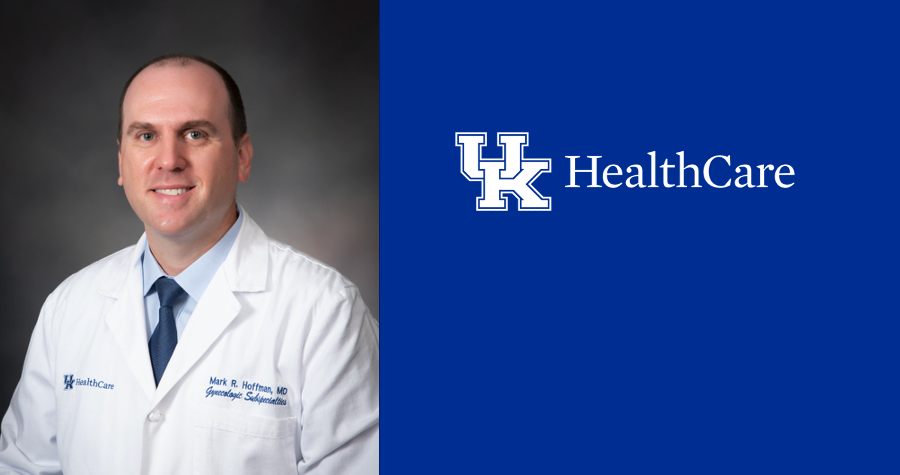Dr. Hoffman on helping patients with fibroids take back their lives

Mark R. Hoffman, MD, a gynecologic surgeon at UK HealthCare Women’s Health Obstetrics & Gynecology, is fellowship-trained in minimally invasive gynecologic surgery. His focus is on medical and minimally invasive surgical treatments for gynecologic problems, including fibroids, endometriosis, abnormal uterine bleeding and chronic pelvic pain. His primary research interests are uterine fibroids and patient outcomes after minimally invasive surgeries. Dr. Hoffman earned his medical degree from UK, completed his residency at the University of Chicago and spent two years as a fellow in minimally invasive surgery and chronic pelvic pain at the University of Michigan.
If you have uterine fibroids, you are not alone. About 50 percent of women develop these noncancerous tumors in or on their uterus during their reproductive years; by menopause, two-thirds of women have them. Fibroids can be tiny or as large as melons, and women can have one or several.
Much of the time, fibroids don’t cause problems, so treatments or interventions aren’t needed. A lot of women don’t even know they have them.
But when fibroids do cause problems, they can make life miserable, causing heavy menstruation, irregular and prolonged periods, and chronic pain or pressure in the pelvic area. If fibroids are large and press on the urinary tract or the intestines, a woman might experience frequent or difficult urination or become constipated. Large fibroids can also make sex painful, contribute to infertility and cause problems with pregnancies.
Most women seek treatment for fibroids in their 30s and 40s, although teens and women in their 20s can have fibroid problems, too. Because fibroids are sensitive to estrogen, they usually don’t grow after the onset of menopause.
When fibroids are an issue, women are often told that an abdominal hysterectomy is their only option, but that is rarely the case. Alternatives like hormone therapies and IUDs, and minimally invasive procedures that remove or shrink fibroids work well for many women, even those with large fibroids.
Still, some 400,000 hysterectomies are performed each year, and many of them, women’s health experts say, are not medically necessary. And if hysterectomy is needed, a minimally invasive surgery can dramatically decrease risks and complications compared with the traditional open surgery.
In regard to fibroid treatment, better education is needed. A study commissioned by the Society of Interventional Radiology found that a quarter of women surveyed had never heard of uterine fibroids and 20 percent thought a hysterectomy was the only treatment available.
An OB/GYN practice that specializes in advanced treatments for fibroids can help women learn more about fibroids and effective ways to treat them, beyond hysterectomy.
Medical and surgical treatments
As a first step, nonsurgical treatments can be effective in treating fibroids. Hormonal treatments, like birth control pills, or an IUD, work well for many patients, giving them relief from their bleeding and pain and eliminating or delaying the need for surgical treatments.
If those treatments don’t work, fibroids usually can be removed or shrunk without removing the uterus by using minimally invasive procedures.
These procedures do not require large incisions. Instead of traditional surgical instruments, tiny cameras and instruments are used to perform laparoscopic surgery.
During a laparoscopic myomectomy, surgeons remove fibroids using a laparoscope – a slender tool with a video camera – and tiny instruments through small slits in the navel and abdomen.
A hysteroscopic myomectomy requires no incisions, as small instruments are inserted through the vagina and cervix into the uterus.
At UK HealthCare, we bring together specialists in women’s health, minimally invasive surgery and interventional radiology to provide patients with the latest treatments and a comprehensive approach to care.
One of the minimally invasive options we offer, through our Uterine Fibroid Treatment Program, is uterine fibroid embolization.
During this procedure, an interventional radiologist inserts a catheter that delivers particles to block blood vessels to the fibroids. This causes the fibroids to shrink. The procedure can decrease abnormal uterine bleeding significantly and relieve bulk pressure symptoms. Four out of five patients who have it won’t need a hysterectomy in the next four to five years.
Minimally invasive procedures are safer and have shorter recovery times than open abdominal surgeries. Because there is no large incision, infection risk decreases and healing is faster.
There are still cases where a hysterectomy may be the best treatment for fibroids, especially when women are beyond child-bearing years. But in our practice, this surgery also is typically accomplished using minimally invasive techniques. Roughly 99 percent of hysterectomies at the University of Kentucky Fibroid Treatment Program over the past eight years have been performed laparoscopically.
Focusing on patient needs
At UK HealthCare Women’s Health Obstetrics & Gynecology, we realize that women want answers and relief, and we work hard to see patients quickly. Among our options is a UK TeleCare virtual appointment, which allows patients to meet with one of our providers from the comfort of home, eliminating the need for travel or missed work.
We strive to help patients with fibroids know and understand their options. Empowering women to make the best decisions for their individual needs and health is at the heart of what we do.
To learn more about uterine fibroid treatment, visit ukhealthcare.com/fibroids. To make an appointment, call 859-323-0005.





